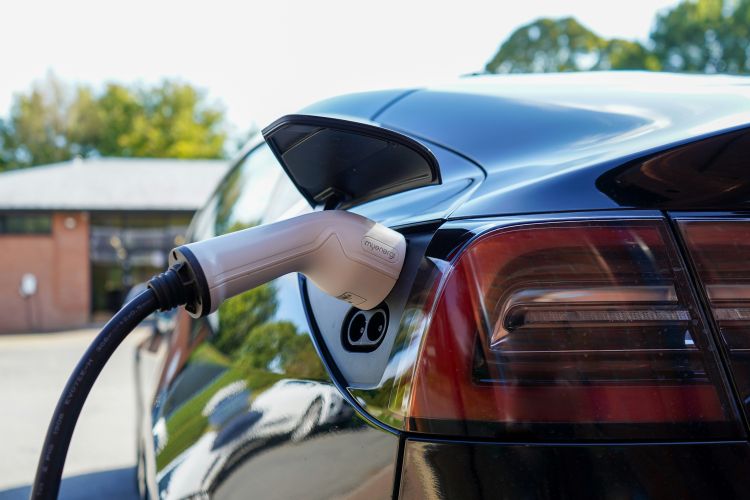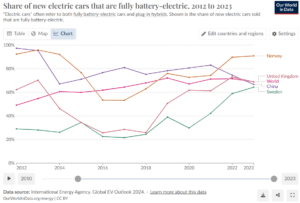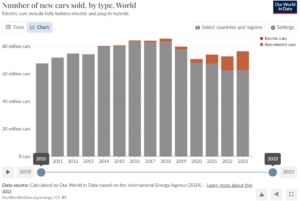
The decision by the Uttar Pradesh government to waive registration tax for hybrid cars has reignited the ongoing debate between electric vehicles (EVs) and hybrids. This policy shift, intended to boost the adoption of more environment-friendly vehicles, has sparked controversy among car manufacturers, and raised important questions about the future of sustainable mobility in India.
On July 5, the Uttar Pradesh government announced the waiver of the registration fee on strong and plug-in hybrid cars, aiming to promote vehicles that offer a middle ground between traditional internal combustion engines and fully electric vehicles. This decision was welcomed by hybrid car manufacturers such as Maruti Suzuki India, Toyota Kirloskar Motor, and Honda Cars India, which say their strong hybrid models meet the state’s performance and efficiency criteria under the Electric Vehicle Manufacturing and Mobility Policy (EVMMP) 2022.
READ | India to boost critical minerals mining for clean energy security
During a meeting with the state’s transport department on July 11, these manufacturers said that increased sales of hybrid cars would primarily replace petrol and diesel cars, rather than cannibalising the market for electric cars. They emphasised that this shift would still contribute to the government’s goal of reducing overall carbon emissions. In contrast, companies like Tata Motors and Mahindra & Mahindra, which focus exclusively on electric vehicles, opposed the move, arguing that incentives for hybrids could slow the growth of the EV market.
The environmental impact: EVs vs Hybrids
Electric vehicles are widely regarded as a key solution for decarbonising transport. Despite the higher emissions during manufacturing, EVs tend to have a significantly lower carbon footprint over their lifetime compared with petrol or diesel cars. This is especially true in regions where the electricity grid is progressively decarbonising.

However, hybrids, which combine an internal combustion engine with an electric motor, present a more complex environmental picture. Conventional hybrids, like the Toyota Prius, use regenerative braking to recharge their batteries but still rely on gasoline, albeit less frequently than traditional cars. Plug-in hybrids offer a larger electric range and can be charged from an external power source, potentially reducing emissions further. Yet, studies show that in practice, many plug-in hybrid owners do not regularly charge their vehicles, leading to higher-than-expected emissions.

While hybrids are more fuel-efficient than pure internal combustion engine vehicles, they are not as clean as battery electric cars. This fact is at the heart of the debate: are hybrids a stepping stone towards full electrification, or do they delay the necessary transition to zero-emission transport?
Global trends and perspectives
The global scenario further complicates the EVs vs hybrids debate. Countries like Norway and China have aggressively pursued policies that favour electric vehicles, resulting in significant market shares for EVs. Norway, for instance, saw over 90% of new cars sold in 2023 being electric, thanks to substantial government incentives and robust charging infrastructure. China’s focus on reducing urban air pollution has driven it to become a leader in EV adoption, with almost 40% of new car sales being electric last year.
Despite these successes, the journey towards full electrification is not uniform across the globe. In the United States, for example, the rise in hybrid sales has mirrored some of the trends seen in India, where consumers are drawn to the perceived reliability and familiarity of hybrid technology. This is particularly notable in regions where charging infrastructure is still developing, and range anxiety remains a significant barrier to EV adoption.
Europe presents a mixed picture, with countries like Germany and the UK making substantial investments in EV infrastructure while also seeing a steady demand for hybrids. These nations are leveraging both technologies as complementary solutions to reduce emissions and transition towards greener transport systems.
These global examples underscore the importance of tailored approaches to vehicle electrification. While hybrids can serve as an effective transitional technology in markets where EV infrastructure is nascent, the ultimate goal should remain the widespread adoption of fully electric vehicles. Policies must therefore be dynamic, adapting to the specific needs and readiness of each region while keeping the long-term objective of zero-emission transport in clear sight.
Market dynamics and consumer trends
Globally, the market for electric vehicles is expanding rapidly. In 2023, one in four new cars sold was electric, with significant market shares in countries like Norway and China. However, hybrids have also seen a surge in popularity, particularly in regions where consumers are hesitant about the range limitations and higher upfront costs of EVs.
In India, the automotive market is undergoing a significant transformation. Analysts predict a slowdown in the auto components industry in FY25, with companies betting heavily on the EV sector to sustain growth. This context underscores the strategic importance of government policies in shaping market dynamics. The UP government’s tax waiver for hybrids could influence consumer behaviour, potentially diverting some buyers from EVs to hybrids due to perceived benefits such as longer range and lower purchase costs.
The way ahead
The Uttar Pradesh government’s decision to incentivise hybrid cars by waiving road tax highlights the ongoing tension between promoting immediate reductions in emissions through hybrids and driving long-term sustainability through a full transition to EVs. While hybrids can play a role in reducing carbon emissions, they are not a substitute for the deep emissions cuts that fully electric vehicles promise.
For India to achieve its climate goals, policies need to encourage the adoption of the cleanest technologies available. This includes not only supporting the growth of the EV market through incentives and infrastructure development but also ensuring that hybrids serve as a bridge rather than a detour on the path to zero emissions. Enhanced public awareness about the true environmental impact of hybrids versus EVs, coupled with strategic policy measures, can help align consumer choices with the broader goal of sustainable transportation.
The debate between EVs and hybrids is not just about technology but also about timing and transition strategies. As Uttar Pradesh and other Indian states address this complex situation, the focus must remain on fostering a market environment that supports the rapid adoption of the cleanest and most efficient vehicle technologies available.
